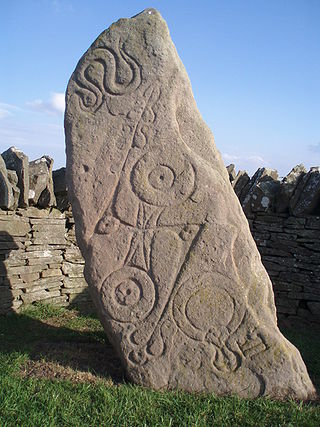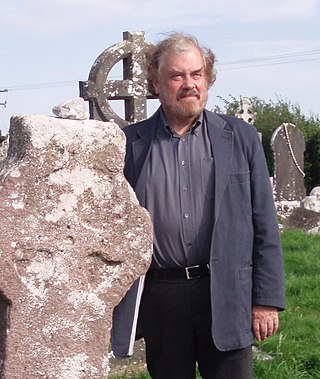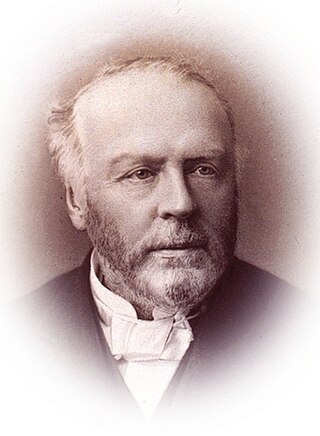Benjamin T. Hudson is an American medievalist based at Pennsylvania State University in State College, Pennsylvania. He received his Bachelor of Arts degree at Pennsylvania State University, received his Masters at University College, Dublin, and his D.Phil. at Worcester College, Oxford. He specializes in the history of Celtic-speaking peoples in the British Isles in the Early and High Middle Ages, and in the Norse-Gaelic Irish Sea region of the same period.

The Picts were a group of peoples who lived in Britain north of the Forth–Clyde isthmus in the Pre-Viking, Early Middle Ages. Where they lived and details of their culture can be inferred from early medieval texts and Pictish stones. The term Picti appears in written records as a Latin pejorative exonym from the third century CE, but was adopted as an endonym in the late seventh century during the Verturian hegemony. This lasted around 160 years until the succession of the Alpínid dynasty, when the Pictish kingdom merged with that of Dál Riata to form the Kingdom of Alba. The concept of "Pictish kingship" continued for a few decades until it was abandoned entirely as a contemporary signifier during the reign of Caustantín mac Áeda.

Rǫgnvaldr Óláfsson was a twelfth-century King of the Isles, succeeding the warrior Somerled. He was a son of Óláfr Guðrøðarson, King of the Isles and a member of the Crovan dynasty. In the 1153, Óláfr was assassinated by three nephews, before his son, Guðrøðr, was able to overcome them and succeed his father as king. By 1158, Guðrøðr was forced from power by his brother-in-law, Somairle mac Gilla Brigte, who was married to Óláfr's daughter Ragnhildr. In 1164, when Somairle was killed in an invasion of Scotland, and while Guðrøðr was away in exile overseas, Rǫgnvaldr briefly seized the kingship for himself, before being overcome by Guðrøðr, who had him blinded and mutilated.
Prof Kenneth Hurlstone Jackson CBE FRSE FSA DLitt was an English linguist and a translator who specialised in the Celtic languages. He demonstrated how the text of the Ulster Cycle of tales, written circa AD 1100, preserves an oral tradition originating some six centuries earlier and reflects Celtic Irish society of the third and fourth century AD. His Celtic Miscellany is a popular standard.
Godred Crovan, known in Gaelic as Gofraid Crobán, Gofraid Meránach, and Gofraid Méránach, was a Norse-Gaelic ruler of the kingdoms of Dublin and the Isles. Although his precise parentage has not completely been proven, he was certainly an Uí Ímair dynast, and a descendant of Amlaíb Cúarán, King of Northumbria and Dublin.
Gofraid mac Fergusa is an alleged ninth-century figure attested by the Annals of the Four Masters and various pedigrees concerning the ancestors of Clann Somhairle and Clann Domhnaill. If the pedigrees are to be believed, he was a son of Fergus mac Eirc, and a descendant of Colla Uais. Likewise, the two annal-entries that note Gofraid mac Fergusa claim that he was an Airgíallan ruler, who aided Cináed mac Ailpín in 835, and died sixteen years later as a ruler of the Isles. Gofraid mac Fergusa's place in the aforesaid pedigrees is chronologically impossible. The events associated with him by the annals are not supported by any contemporary or near contemporary source. In fact, the two annal-entries that recount these alleged events are fabricated additions inserted into the chronicle at some point before the mid seventeenth century.

Scotland in the Middle Ages concerns the history of Scotland from the departure of the Romans to the adoption of major aspects of the Renaissance in the early sixteenth century.

The Norse–Gaels were a people of mixed Gaelic and Norse ancestry and culture. They emerged in the Viking Age, when Vikings who settled in Ireland and in Scotland became Gaelicised and intermarried with Gaels. The Norse–Gaels dominated much of the Irish Sea and Scottish Sea regions from the 9th to 12th centuries. They founded the Kingdom of the Isles, the Kingdom of Dublin, the Lordship of Galloway, and briefly ruled the Kingdom of York. The most powerful Norse–Gaelic dynasty were the Uí Ímair or House of Ivar.
Arthgal ap Dyfnwal was a ninth-century king of Alt Clut. He descended from a long line of rulers of the British Kingdom of Alt Clut. Either he or his father, Dyfnwal ap Rhydderch, King of Alt Clut, may have reigned when the Britons are recorded to have burned the Pictish ecclesiastical site of Dunblane in 849.

Peter Berresford Ellis is a British historian, literary biographer, and novelist who has published over 98 books to date either under his own name or his pseudonyms Peter Tremayne and Peter MacAlan. He has also published 100 short stories. Under Peter Tremayne, he is the author of the international bestselling Sister Fidelma historical mystery series. His work has appeared in 25 languages.
Amlaíb mac Illuilb was a tenth-century King of Alba. He was one of three sons of Illulb mac Custantín, King of Alba, and a member of Clann Áeda meic Cináeda, a branch of the Alpínid dynasty. Amlaíb's paternal grandfather possessed strong connections with the Scandinavian dynasty of Dublin, and there is evidence to suggest that Illulb and Amlaíb bore names of Old Norse origin. If Amlaíb's name indeed represents a Gaelicised Scandinavian name, it could indicate that his mother was a member of the Uí Ímair, and possibly a granddaughter of Amlaíb Cúarán or Amlaíb mac Gofraid.

Thomas Mowbray Charles-Edwards is an emeritus academic at the University of Oxford. He formerly held the post of Jesus Professor of Celtic and is a Professorial Fellow at Jesus College.
Donnchadh Ó Corráin was an Irish historian and Professor Emeritus of Medieval History at University College Cork. He earned his BA in history and Irish from that institution, graduating in 1964.
Maccus mac Arailt, or Maccus Haraldsson, was a tenth-century King of the Isles. Although his parentage is uncertain, surviving evidence suggests that he was the son of Harald Sigtryggson, also known as Aralt mac Sitriuc, the Hiberno-Norse King of Limerick. Maccus' family is known as the Meic Arailt kindred. He and his brother, Gofraid, are first recorded in the 970s. It was during this decade and the next that they conducted military operations against the Welsh of Anglesey, apparently taking advantage of dynastic strife within the Kingdom of Gwynedd.
Flann Mainistrech was an Irish poet and historian.

Sir John Thomas Gilbert, LLD, FSA, RIA was an Irish archivist, antiquarian and historian.
Gofraid is an Irish masculine given name, arising in the Old Irish and Middle Irish/Middle Gaelic languages, as Gofhraidh, and later partially Anglicised as Goffraid.
Ragnall, Raghnall, Raonall, and Raonull are masculine personal names or given names in several Gaelic languages.
Ragnall mac Gofraid was King of the Isles and likely a member of the Uí Ímair kindred. He was a son of Gofraid mac Arailt, King of the Isles. Ragnall and Gofraid flourished at a time when the Kingdom of the Isles seems to have suffered from Orcadian encroachment at the hands of Sigurðr Hlǫðvisson, Earl of Orkney. Gofraid died in 989. Although Ragnall is accorded the kingship upon his own death in 1004 or 1005, the succession after his father's death is uncertain.

Ímar mac Arailt was an eleventh-century ruler of the Kingdom of Dublin and perhaps the Kingdom of the Isles. He was the son of a man named Aralt, and appears to have been a grandson of Amlaíb Cuarán, King of Northumbria and Dublin. Such a relationship would have meant that Ímar was a member of the Uí Ímair, and that he was a nephew of Amlaíb Cuarán's son, Sitriuc mac Amlaíb, King of Dublin, a man driven from Dublin by Echmarcach mac Ragnaill in 1036.
Domnall mac Áeda, also known as Domnall Dabaill, was a King of Ailech. He was a son of Áed Findliath mac Niall, High King of Ireland. Domnall was a half-brother of Niall Glúndub mac Áeda, a man with whom he shared the kingship of Ailech. From Domnall would descend the Mac Lochlainn dynasty.